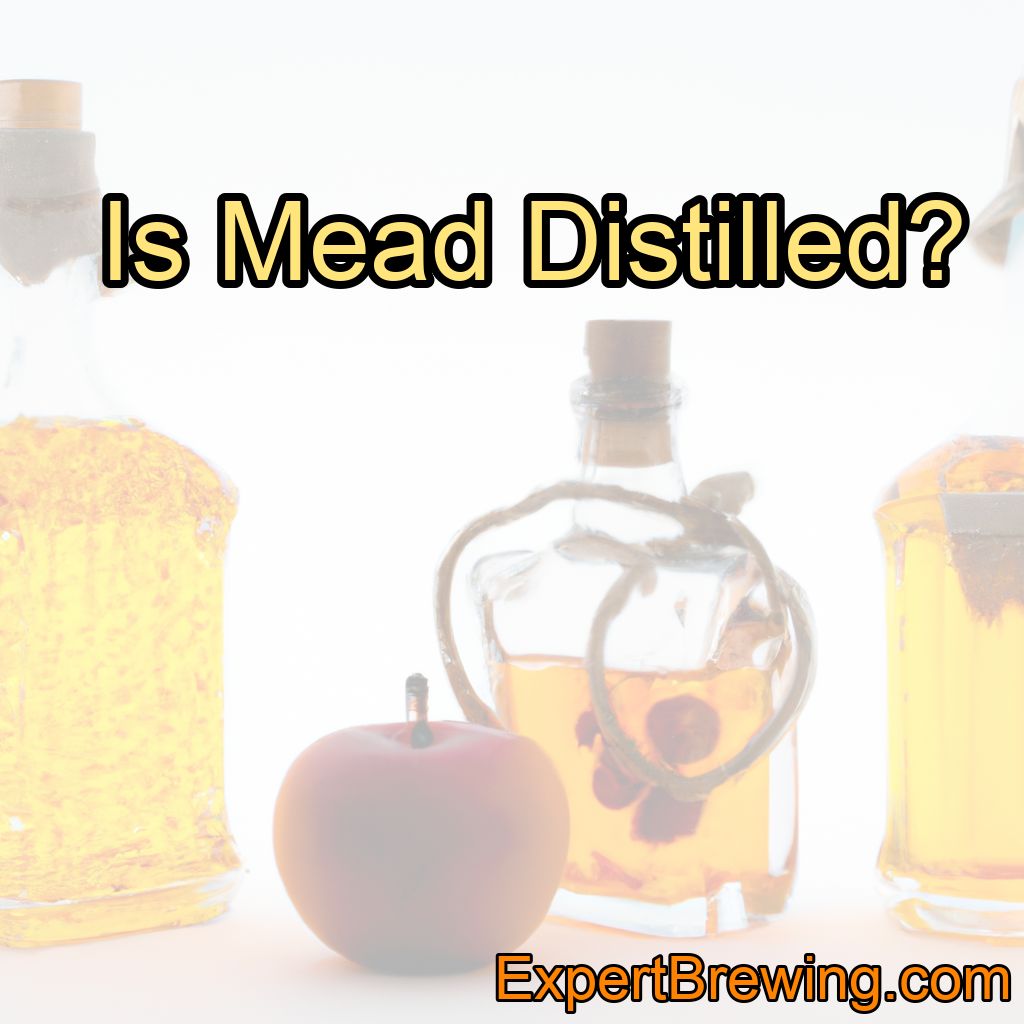Is mead distilled? The short answer is no, mead is not distilled.
Mead, also known as honey wine, is a fermented beverage made from honey, water, and sometimes additional flavorings or spices. Distillation, on the other hand, is a process that involves heating a liquid to create vapor, then cooling that vapor back into a liquid to separate the components and increase the alcohol content.
While some spirits and liquors are made by distilling fermented beverages, mead is not one of them. In this blog post, we will delve deeper into the world of mead and explore its history, production process, and various types of mead, as well as some tips for making and enjoying mead at home.
History of Mead
Mead has a long and storied history, with evidence of its production dating back thousands of years. Archaeological evidence suggests that mead was produced as far back as 7000 BC in Northern China, where pottery vessels containing a mixture of honey, rice, and fruit were discovered.

Mead also features prominently in ancient mythology and literature, with references to the beverage appearing in texts such as the Rigveda, the Icelandic sagas, and the works of Greek philosophers like Aristotle and Pliny the Elder.
Throughout history, mead has been regarded as a drink of the gods, a symbol of wealth and status, and a potent aphrodisiac. In some cultures, it was even believed to possess magical and medicinal properties.
Today, mead is experiencing a resurgence in popularity among craft beverage enthusiasts, who appreciate its unique flavor profiles and the creative possibilities it presents for home brewing and experimentation.
Mead Production Process
Fermentation
The process of making mead begins with fermentation, which is the conversion of sugars in the honey into alcohol by yeast. This is the same process that occurs in the production of beer and wine, although the specific strains of yeast used in mead-making may differ from those used in other fermented beverages.
To start the fermentation process, honey is mixed with water to create a solution known as “must.” The specific ratio of honey to water will vary depending on the desired sweetness and alcohol content of the finished mead.
Once the must has been prepared, it is typically heated to a temperature that will kill off any wild yeasts or bacteria that may be present in the honey. This step, known as pasteurization, helps to ensure a consistent and controlled fermentation process.
After the must has been pasteurized, it is cooled to a temperature that is suitable for the addition of yeast. The yeast will then begin to consume the sugars in the honey, producing alcohol and carbon dioxide as byproducts.

The fermentation process can take anywhere from a few weeks to several months, depending on factors such as the type of yeast used, the specific gravity of the must, and the desired flavor profile of the finished mead.
Aging
Once fermentation is complete, mead is typically aged for a period of time to allow the flavors to mature and mellow. This can be done in a variety of vessels, including glass carboys, stainless steel tanks, or even oak barrels.

The length of the aging process will vary depending on the style of mead being produced and the preferences of the mead maker, but it is generally recommended that mead be aged for at least several months to a year.
Types of Mead
There are many different types of mead, each with its own unique flavor profile and characteristics. Some of the most common styles of mead include:
Traditional mead
Traditional mead, also known as “show mead,” is made using only honey, water, and yeast. This style of mead showcases the natural flavors of the honey and can range from dry to sweet, depending on the amount of honey used in the must.
Melomel
Melomel is a type of mead that is made by adding fruit or fruit juice to the must. This can include a wide variety of fruits, such as berries, cherries, peaches, or even tropical fruits like pineapple or mango. The addition of fruit can impart additional flavors and complexity to the finished mead, as well as a vibrant color.
Metheglin
Metheglin is a mead that is made with the addition of spices or herbs, such as cinnamon, cloves, or lavender. These added ingredients can lend unique flavors and aromas to the finished mead, and can be used in combination with fruits or other flavorings to create complex and interesting mead recipes.
Making Mead at Home
Equipment Needed
If you’re interested in trying your hand at making mead at home, you’ll need some basic equipment to get started. This includes:
- A fermentation vessel, such as a glass carboy or food-grade plastic bucket
- An airlock to allow carbon dioxide to escape during fermentation
- A hydrometer to measure the specific gravity of the must and track fermentation progress
- A thermometer to monitor temperatures during pasteurization and fermentation
- A siphon and bottling equipment for transferring and packaging the finished mead
Ingredients
In addition to the basic equipment, you’ll also need a few key ingredients for making mead:
- Honey: The quality and flavor of the honey you use will have a significant impact on the taste of your finished mead, so it’s important to choose a high-quality, unprocessed honey. Many mead makers recommend using local, raw honey for the best results.
- Water: As with any fermented beverage, the quality of the water used in the must is important. If your tap water has a strong flavor or contains high levels of chlorine, you may want to consider using filtered or spring water instead.
- Yeast: There are many different strains of yeast that can be used for mead-making, each with its own unique characteristics and flavor profiles. Some popular choices include champagne yeast, ale yeast, and specialized mead yeasts.
Tips for Enjoying Mead
Mead can be enjoyed in a variety of ways, depending on your personal preferences and the specific style of mead you’re drinking. Here are a few tips for making the most of your mead-drinking experience:
- Serve mead chilled or at room temperature, depending on the style and your personal preference.
- Try pairing mead with different types of foods to see how the flavors complement each other. Mead can be a great accompaniment to cheese plates, desserts, and even savory dishes.
- Experiment with different types of mead to find the styles and flavors that you enjoy the most. There is a wide world of mead out there to explore, so don’t be afraid to try something new!
Conclusion
In conclusion, mead is not distilled; it is a fermented beverage made from honey, water, and sometimes additional flavorings or spices. This ancient drink has a rich history and offers a unique and diverse range of flavors and styles for enthusiasts to explore. Whether you’re a home brewer looking to try your hand at making your own mead or simply a fan of fermented beverages looking for something new to try, mead is a delicious and intriguing option worth considering.
10 Facts about Mead
1. Mead is not distilled; it is fermented.
2. Mead is sometimes referred to as honey wine.
3. Evidence of mead production dates back to 7000 BC in Northern China.
4. Mead is mentioned in ancient texts such as the Rigveda, Icelandic sagas, and the works of Greek philosophers.
5. The production process for mead involves fermentation and aging.
6. There are various types of mead, including traditional mead, melomel, and metheglin.
7. Mead can be made at home with basic brewing equipment and high-quality honey, water, and yeast.
8. Mead can range in flavor from dry to sweet, depending on the amount of honey used in the must.
9. Mead can be enjoyed at a variety of temperatures and can be paired with different types of food for an enhanced tasting experience.
10. Mead is experiencing a resurgence in popularity among craft beverage enthusiasts.
FAQs
Do you have to use spring water for mead?
No, you do not have to use spring water for mead. However, it is recommended to use water that is free from chlorine and other chemicals that may affect the flavor of the mead. Filtered or distilled water can also be used as a substitute.
Can you use distilled water in mead?
Yes, distilled water can be used in mead-making as it is free of impurities and minerals that can affect the flavor and clarity of the final product. However, it is important to note that using only distilled water may result in a lack of essential minerals that yeast require for healthy fermentation, so it is recommended to add yeast nutrient or use a blend of distilled and mineral water.
Do you have to use distilled water for mead?
No, you do not have to use distilled water for mead. However, it is recommended to use water that is free of chlorine or other chemicals that may affect the flavor of the mead. Boiling tap water or using filtered water can also be effective in removing these chemicals.
Can I use distilled water for brewing?
Yes, you can use distilled water for brewing. However, it is important to note that distilled water lacks minerals that are essential for yeast health and flavor development in beer. Therefore, it is recommended to add brewing salts or minerals to the water to achieve the desired mineral content for the specific style of beer being brewed.
What is the best water to use for brewing beer?
The best water for brewing beer is water that is low in minerals and has a neutral pH level, as it allows the flavors of the malt and hops to shine through. However, the specific water profile can vary depending on the style of beer being brewed, as certain styles require different mineral levels for optimal flavor.
Is distilled water OK for mead?
Distilled water can be used for making mead, but it is not recommended as it lacks minerals and nutrients that are important for yeast health and fermentation. It is better to use spring water or tap water that has been treated to remove chlorine and other chemicals.




